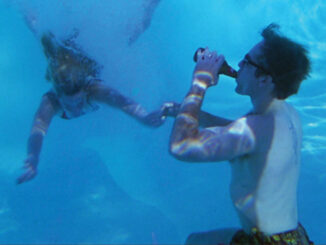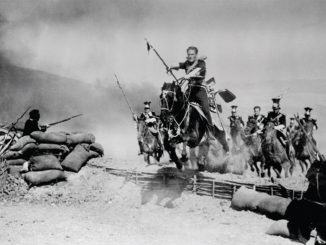
by Kevin Lewis
Hollywood was aghast in 1965 when producer/screenwriter Ernest Lehman announced Elizabeth Taylor and Richard Burton for the roles of the abusive harridan Martha and her angst-ridden, seedy, history-professor husband George in the film version of Who’s Afraid of Virginia Woolf? The 1962 Broadway play was so foul-mouthed that Columbia University overruled its Pulitzer Prize Advisory Board and denied the Pulitzer Prize for drama to the play, awarding no play honor for the year.
Taylor may have been called the last star created by the major studio system, but she was never bound by its conventions. She had starred in Cat on a Hot Tin Roof (1958), Suddenly, Last Summer (1959) and BUtterfield 8 (1960), the latter for which she won her first Oscar. After two decades before the public as the world’s great beauty, and among the top ten box-office stars with artificial movies––including the most celebrated, Cleopatra (1963), which brought the mighty 20th Century-Fox to its knees––Taylor welcomed the opportunity to be repulsive with her great Shakespearean actor mate in Woolf. Life magazine eagerly photographed the production of the movie that may have marked the end of the great tabloid romance of the decade, if the overreaching star had failed.
But instead, Taylor triumphed in June 1966, when the film was released 45 years ago. Playing a dumpy, vulgar woman 20 years older than her 33 years, she won a second Academy Award and dispelled criticism of her limited acting skills. Taylor herself thought her casting was a stretch, but husband-baiting and fighting was an old tabloid game for her, and Burton was already hubby number five––and the second she took from a wife with small children within just five years. Because the public wanted to see the Burtons fight and swear, a long, non-linear film with foul language and despicable behavior amongst four dysfunctional, drunken characters became the third highest-grossing movie of 1966, right after Thunderball and Dr. Zhivago.
Furthering the film’s controversy, Jack Warner of Warner Bros., who originally bought the play to star Bette Davis and James Mason (Henry Fonda was playwright Edward Albee’s original choice), refused to significantly alter the play to gain a seal of approval from the Motion Picture Production Association. His studio had a long tradition of adapting serious plays for the screen, and Warner had already locked horns with the Production Code on A Streetcar Named Desire (1951) and prevailed on many points. After Warner sent the Woolf script to Geoffrey Shurlock, then head of the MPPA, it was returned with numerous pages marked in red, and Shurlock told him the film could not be made––which only made Warner see red.
The irony is that the famous couple was already deconstructing; each of their careers arguably peaked with Woolf.
During production, director Mike Nichols made it clear that he would not shoot alternate scenes to replace the objectionable ones. As a result, Jack Valenti, just a month into his new position as the film czar of the MPAA––and with the added controversy of Blow-Up from MGM that same year––was compelled to dismantle the archaic Hays Office Production Code and eventually institute the Ratings Systems (G, M, R, X) in 1968. The film itself was released with the warning that no one under the age of 18 would be admitted without a parent. The dismantling of the Production Code is one of the many lasting film legacies of La Liz, who passed away at age 79 this March.
Who’s Afraid of Virginia Woolf? reflected many of the anxieties of the buttoned-down 1950s and 1960s. Psychologist Eric Berne published the defining book of the era, Games People Play: The Psychology of Human Relationships, in 1964. The dysfunctions and complexes that result when the three ego states of Child, Adult and Parent are confused were analyzed in a series of destructive games played daily by couples, parents, children, friends and co-workers.
Albee, who had previously written one acts, including The Zoo Story, The American Dream and The Sandbox in the manner of the Theatre of the Absurd, wrote Woolf using such nasty mind games as a dramatic device. He found his inspiration for the characters of George and Martha in his friends––the couple Willard Maas and Marie Menken, experimental filmmakers who both appeared in Andy Warhol movies. A visit to Wagner College on Staten Island for his play The Zoo Story gave him the idea of a night of vicious biographical games and booze played by a failed New England university professor and his hate-filled wife, who was the college president’s daughter, with an unsuspecting but ambitious biology professor and his pregnant, brandy-loving child-wife.
“Get the guests” and “Hump the hostess” were just some of their crude games. The roles of child, adult and parent were interchanged throughout the night. Besides the child in the womb, there is an imaginary child of George and Martha that causes the showdown between them. The title itself is a tribute to the smug university game of bad punning (“Who’s Afraid of the Big, Bad Wolf?”).
John Frankenheimer was Lehman’s original choice for director, but the Burtons wanted their friend Nichols, who, with his writing partner and performer Elaine May, became national favorites on The Ed Sullivan Show portraying, among others, a mother-dominated astronaut, an overwhelmed doctor and nurse and a venal mortician with wicked satire. Like Albee, who removed the graduation gown from university professors, Nichols and May deconstructed America’s heroes. Nichols emphasized the dark, sick humor in the play and its characters.
For Woolf, his first film, Nichols was inspired by the films of Elia Kazan, especially the claustrophobic A Streetcar Named Desire (1951). Lehman wanted the film opened up––which Nichols resisted––and, except for the scene at the roadhouse, the establishing shot of the old wood house and the tree swing scene in the yard, the film is set in the dark, “What a dump!” house, brilliantly designed by Oscar-winning Richard Sylbert.
The Burtons considered their previous work together (Cleopatra, The V.I.P.s, both 1963; The Sandpiper, 1965) schlock––an embarrassment to Burton, who had just played a sold-out run of Hamlet on Broadway, and to Taylor, who wanted to show the world that she could be a Vivien Leigh to the successor to Laurence Olivier. So they enthusiastically shed their glamorous, romantic images for Woolf. Sandy Dennis, who had won back-to-back Tony Awards for comedies, was cast as the young bride of opportunistic professor Nick, played by George Segal, who had originally made his theatrical mark as one of the cast of the improvisational revue The Premise.
Nichols bonded with the film’s editor Sam O’Steen, a connection that encompassed 11 movies from 1966 to 1994. O’Steen’s widow, editor/author Bobbie O’Steen, recalls Nichols as intellectual and funny, and her late husband as down to earth. “They were similar in a lot of ways, and respected one another’s strengths,” she recalls. “I think Sam’s personal accessibility helped smooth things over with the crew for Nichols.” O’Steen, a major Warner Bros. editor of the glossy Frank Sinatra films, was on the set of Woolf every day, working with both Nichols and DP Haskell Wexler. Wexler’s background was in documentaries and the gritty, post-noir, black-and-white films of Irving Lerner and Irvin Kershner.
In his interview on the DVD of Who’s Afraid of Virginia Woolf?, Wexler says that the crew helped him because he was uncertain, but his harsh, clinical cinematography was innovative, especially with major box-office stars. Wexler filmed some of the scenes with a hand-held camera, such as in the scene where George walks to the back of the house to get his rifle to “shoot” Martha. When Honey (Sandy Dennis) reverts to childhood in her dance, Wexler tied himself to her waist with a five-foot-long rope to execute a 360-degree shot. He won the last Oscar given for black-and-white cinematography. O’Steen was nominated for his editing, but his sound contributions, as were those of M.A. Merrick (the credited sound editor), were absorbed into the sound Oscar nomination which was given to George Groves, head of the Warner sound department.
Nichols asked O’Steen if he could edit overlapping dialogue, which Nichols had been told couldn’t be accomplished. According to his widow, O’Steen mixed the separate dialogue tracks of Taylor and Burton with the film image. A significant number of scenes involved traveling shots with the actors, which eliminated intercutting except for significant reaction shots. This approach may have helped with the overdubbing because the need for precise lip-synching was reduced.
Because Nichols shot the script replete with curse words, Bobbie O’Steen claims that her late husband, in concert with Nichols and Wexler, devised a scene where Taylor had her back to the camera and only turned her face to the camera for the word “you” when the house door opened for Segal and Dennis––allowing the director and sound editor to substitute “God damn you” for “Screw you” without re-shooting or dubbing.
The irony is that the famous couple was already deconstructing; each of their careers arguably peaked with Woolf. With the exception of a variant of that film, the following year’s handsome Franco Zeffirelli production of Shakespeare’s The Taming of the Shrew, the Burtons’ succeeding six films either bombed or went unnoticed, and Burton’s only hits were Taylor-less.
Be careful what you wish for; Who’s Afraid of Virginia Woolf? revealed truths about the couple’s innate love of infighting and alcoholism, and they divorced because Taylor, according to Burton’s biographer Melvyn Bragg, “became tired of being Martha in real life.”





